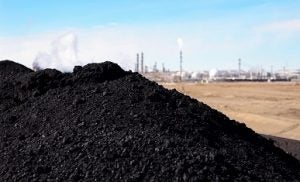Here’s why putting more tax dollars behind coal is such a wasteful proposition
 West Virginia Gov. Jim Justice just pitched a coal boondoggle to President Donald Trump. And boy oh boy, it’s a doozy.
West Virginia Gov. Jim Justice just pitched a coal boondoggle to President Donald Trump. And boy oh boy, it’s a doozy.
Justice, who made news recently for announcing at a Trump rally that he was switching from the Democratic to the Republican party, is a billionaire climate denier who owns a host of companies, including a golf course and casino and who put his children in charge of his empire while he is governor. Sound familiar?
He also owns several coal mines and was delinquent on $2 million in mine safety violations until a 2014 story by National Public Radio prompted him to start paying his fines.
So let’s have a closer look at the governor’s pitch. Turns out, it’s a really lousy deal for American taxpayers and coal workers alike – while doing nothing for energy security.
A $4.5-billion bill for American taxpayers
Justice wants Trump to play favorites not just with coal, but with coal mined specifically in Appalachia, which includes coal-heavy states such as West Virginia, Kentucky, Tennessee and Pennsylvania. Eastern power companies would get a federal subsidy of $15 per ton of Appalachian coal they purchase to generate electricity.
[Tweet “Here’s why putting more tax dollars behind coal is such a wasteful proposition”]
Doing so would cost taxpayers as much as $4.5 billion per year and benefit only the coal companies in Justice’s region. The West Virginia governor claims this is important because, in his view, the decline of Appalachian coal poses a national security threat – meaning a bomb could take out natural gas plants or trains carrying coal from Western states.
National security aside, let’s imagine for a minute what $4.5 billion could do for Appalachia if we spent it to really help this struggling region.
Lost opportunity: workers need retraining
Since he cares about jobs, Trump could take half of the $4.5 billion to create a life-changing job training program in Appalachia to retrain coal industry workers for 21st century jobs in the solar or energy efficiency fields, for example. The other half could pay each worker $65,000 a year while they’re in training.
Though unique, this approach puts hardworking Americans first while investing in our economy.
To put things in perspective, $4.5 billion annually is so much money it equals more than $130,000 a year for each and every coal employee in northern and central Appalachia, The Washington Post has reported.
Instead, Gov. Justice wants all of that money to prop up eastern coal which, even with the $15 per ton subsidy, would still be three times as expensive as coal from Wyoming’s Powder River.
Subsidies can’t help coal survive
Coal and other fossil fuels helped build out the U.S. energy infrastructure a century ago. But today, any tax break or direct subsidy to the coal industry is little more than a government handout to an industry that’s been steadily declining since the 1980s.
Coal has let our country down many times; does the 2013 “polar vortex” ring a bell?
In an effort to sidestep coal’s obvious economic problem, the industry – and even the new interim chairman of the Federal Energy Regulatory Commission who is a Kentucky native – have been touting coal as the fuel of choice for energy security and grid reliability. Such talking points ignore the fact that more coal will not improve the reliability of the electric grid.
Coal has let our country down many times; does the 2013 “polar vortex” ring a bell? There’s a robust body of research on grid reliability backing up this point, especially in recent years with renewable energy and natural gas loosening coal’s once-dominant stranglehold on the market.
The U.S. Department of Energy’s own draft study shows that more clean energy, and less coal, makes America’s electricity system more affordable and reliable.
Are we safer with coal? Answer is no.
But you recall that Gov. Justice is also pushing the national security angle, another argument we’ve heard from the coal industry since Trump’s inauguration.
It goes like this: The loss of an easy source of power such as coal would render the grid more susceptible to a terror attack. Energy Secretary Rick Perry and EPA Administrator Scott Pruitt have both implied that coal will ease this threat.
Of course, if terrorists want to blow up a natural gas plant or take out a coal train from Wyoming they could just as easily blow up a coal plant.
On the contrary, a more diverse and distributed energy system that’s less reliant on any one source in one location, such as wind and solar, is a better defense against such a fear-mongering hypothetical.
We would applaud the president’s efforts were he indeed willing to invest in the economic revitalization of areas as hard-hit as Appalachia. But handing billions to a few coal mine billionaires as a result of a false national security claim won’t accomplish anything for working Americans or taxpayers.
This post originally appeared on our Voices blog.










